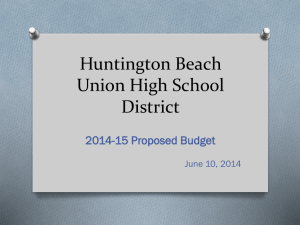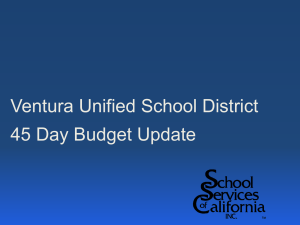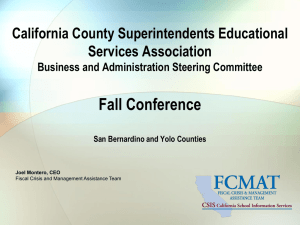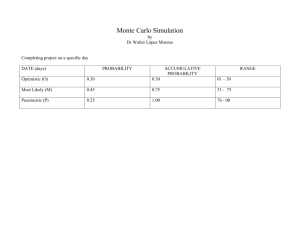State adopts budget - Evergreen School District
advertisement
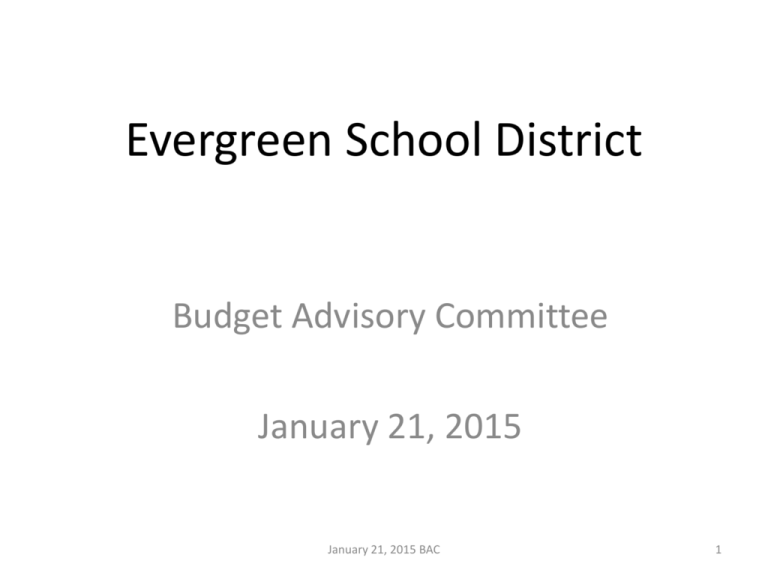
Evergreen School District Budget Advisory Committee January 21, 2015 January 21, 2015 BAC 1 What We’ll Cover • • • • • Review of Budget Cycle Local Control Funding Formula (LCFF) Overview Demographer’s Report - Enrollment Governor’s January Budget Proposal Implications for Education and for Evergreen School District January 21, 2015 BAC 2 Governor's January Budget Proposal First Interim Report (December) District begins to develop its budget Community meetings to gather input on community's priorities District Budget revised (within 45 days of State adopted budget) Second Interim Report Budget Cycle (March) Board work session to share community feedback and establish board budget priorities State adopts budget (by June) Governing Board adopts budget (by June 15) District refines its budget End of Year Report – if not a Positive Second Interim Report Governor's May Revise January 21, 2015 BAC 3 Goals of the LCFF and Its Implementation No district receives less than 2012-13 Funding restored to pre-recession 2007-08 levels Core funding equalized Equity – more services for higher needs Full implementation by 2020-21 Source: School Services of California, Inc. January 21, 2015 BAC 4 Source: EdSource Local Funding Formula January 21, 2015 BAC 5 Before: Rule Based – Now: Outcome Based • Under the LCFF model – Accountability for the use of funds tied to eight areas of state priority – Accountability is linked to a locally developed plan, the Local Control Accountability Plan (LCAP), designed to achieve identified goals – Planning process is intended to be transparent and engage the school community – The district budget is explicitly linked to LCAP goals and activities – Annual review of progress and update of the LCAP is required • Funds are not restricted in the categorical program sense, but – Funds generated by eligible students are intended to be used to improve and increase services for those students – Accountability for demonstrating how funds are used to support student needs is explicitly required as part of the LCAP January 21, 2015 BAC 6 Demographer’s Report – January 8, 2015 Board Presentation Table 1 (PowerPoint version): Actual and Projected Students by Grade and Grade Level, 2014 to 2024 Early Oct. of TK Actual and Projected Total Enrollment by Grade (including SDC in TK-8 but excluding NPS students) K 1 2 3 4 5 6 7 8 Actual and Projected Total Enrollment by Grade Group TK-6 7-8 TK-8 2014 297 1,016 1,196 1,316 1,413 1,480 1,526 1,594 1,506 1,517 9,838 3,023 12,861 2015 2016 270 1,080 1,075 1,216 1,343 1,423 1,491 1,538 1,577 1,523 257 1,029 1,144 1,096 1,243 1,355 1,439 1,505 1,526 1,597 9,436 9,068 3,100 3,123 12,536 12,191 2017 2018 277 1,107 1,094 1,171 1,124 1,258 1,373 1,455 1,495 1,547 282 1,128 1,176 1,119 1,200 1,138 1,276 1,389 1,446 1,516 8,859 8,708 3,042 2,962 11,901 11,670 2019 286 1,143 1,194 1,199 1,144 1,211 1,151 1,288 1,379 1,464 8,616 2,843 11,459 2021 2024 290 1,161 1,213 1,228 1,239 1,232 1,165 1,234 1,152 1,293 301 1,202 1,257 1,259 1,271 1,267 1,273 1,271 1,242 1,177 8,762 9,101 2,445 2,419 11,207 11,520 -402 -770 -979 77 100 19 -325 -670 -960 -1,130 -1,222 -61 -180 -1,191 -1,402 -738 -604 -1,342 Total Grade-Level Change in One Year, to October of 2015 Total Grade-Level Change in Two Years, to October of 2016 Total Grade-Level Change in Three Years, to October of 2017 Total Grade-Level Change in Four Years, to October of 2018 Total Grade-Level Change in Five Years, to October of 2019 Total Grade-Level Change in Ten Years, to October of 2024 Note: Potential short-term deviations from the forecast numbers in TK and K are much greater than usual due to severely divergent findings. The current K enrollment, if it covered a 12-month rather than 11-month period, probably would have over 1,100 students. Local zip code birth data for the ESD vicinity, when correlated forward by five years to the potential TK and K enrollments, indicate a dramatic decline in the pending TK and K amounts compared to that over-1,100 figure. For October 2015, applying only that correlative data and ignoring all other findings could have justified a K expectation of around 1,000 students, with even lower 2016 and 2017 amounts. January 21, 2015 BAC 7 Enrollment and Average Daily Attendance • Enrollment is the total number of students enrolled in the District January 21, 2015 BAC • Average Daily Attendance (ADA) is equal to the average number of pupils actually attending classes • ADA drives a district's primary source of general purpose funding – its LCFF funding • Attendance is counted every day of the school year – LCFF funding, however, is based on attendance through the P-2. P-2 is attendance through the last school month ending on or before April 15 of a school year. January 21, 2015 BAC 8 ADA – Declining Enrollment January 21, 2015 BAC • A drop in ADA will result in a decrease of district LCFF funding, similar to funding under revenue limits • However, the state provides limited protection from revenue losses related to declining enrollment – a district is funded on the greater of current-year or prior-year ADA – The protection provides a revenue floor in the current year for declining enrollment districts – For declining enrollment districts, the current-year ADA will determine next year's revenues January 21, 2015 BAC 9 Themes for the 2015-16 Governor’s Budget • Positive economic growth continues and fuels public education spending • Proposition 98 continues to receive most of the new money • Governor stays the course on the Local Control Funding Formula (LCFF) and the Local Control and Accountability Plan (LCAP) • The Wall of Debt continues to come down and is replaced with the Rainy Day Fund • Overall, a very good State Budget for public education January 21, 2015 BAC 10 Discretionary Funds • The Governor’s State Budget proposal provides more than $1.1 billion in discretionary one-time Proposition 98 funds, including $20 million for COEs – The allocation amounts to about $180 per ADA for districts • The Governor suggests the one-time funds may be used to further investments in the implementation of Common Core State Standards (CCSS) • Other uses detailed in the proposal are: – To support the implementation of newly adopted English language development and California’s Next Generation Science standards, and – To support expenditures that occur due to the evolving accountability structure of the LCFF January 21, 2015 BAC 11 2015-16 Local Control Funding Formula • Budget proposes $4 billion for continued implementation of the LCFF • New funding is estimated to close the gap between 2014-15 funding levels and LCFF full implementation targets by 32.19% • When combined with 2013-14 and 2014-15 LCFF funding, implementation progress would cover almost 58% of the gap in just three years • Individual district experiences will vary January 21, 2015 BAC January 21, 2015 BAC 12 2015-16 LCFF Funding Factors • Cost-of-living adjustment (COLA): The K-12 COLA is 1.58% for 2015-16, and is applied to the LCFF base grants for each grade span Grade Span 2014-15 Base Grant per ADA 1.58% COLA 2015-16 Base Grant per ADA K-3 $7,011 $111 $7,122 4-6 $7,116 $112 $7,228 7-8 $7,328 $116 $7,444 January 21, 2015 BAC 13 2015-16 LCFF Funding Factors • Grade span adjustment is applied as percentage increases against the adjusted base grants, and also receives a 1.58% COLA in 2015-16 January 21, 2015 BAC – Grade K-3 – 10.4% increase for smaller average class enrollments Grade Span 2015-16 Base Grant per ADA Grade Span Adjustment 2015-16 Adjusted Grants K-3 (10.4%) $7,122 $741 $7,863 4-6 $7,228 -- $7,228 7-8 $7,444 -- $7,444 January 21, 2015 BAC 14 What Does the LCFF Mean for Evergreen School District ? 1st Interim January 2015 1st Interim January 2015 1st Interim January 2015 Projection Projection Difference Projection Projection Difference Projection Projection Difference COLA 2014-15 2015-16 2016-17 0.85% 2.19% 2.14% 0.85% 1.58% 2.10% Funding GAP 0.00% -0.61% -0.04% District ADA 2014-15 2015-16 2016-17 29.56% 20.68% 25.48% 29.15% 32.19% 11.00% District Enrollment -0.41% 11.51% -14.48% % of Attendance 12,873 12,624 12,396 12,850 12,536 12,191 (23) (88) (205) Special ED Student at County ADA 12,564 12,514 (50) 97.60% 97.39% -0.21% 108 108 12,321 12,223 (98) 97.60% 97.50% -0.10% 108 108 12,099 Note: 11,886 (213) the 97.60% 97.50%Simulator -0.11% to generate 108 108 Please use SSC LCFF 0 0 0 your district’s to insert in the tableTotal above. LCFF Supplemental Grant unique Funding numbers LCFF Entitlement PER ADA LCFF Revenue 2014-15 $5,657,797 2015-16 $6,174,015 2016-17 $6,662,145 $5,717,528 $6,550,264 $6,733,902 Discretionary Funds - One Time $59,731 $376,249 $71,757 $6,757 $7,093 $7,459 $6,755 $7,259 $7,408 ($2) $166 ($51) $87,571,196 $87,540,256 ($30,940) $89,884,405 $91,628,368 $1,743,963 $92,703,322 $91,349,340 ($1,353,982) $180 (one-time) X 2014-15 P-2 ADA $2,252,520 January 21, 2015 BAC 15 CalSTRS Rate Increases • Employer rates are increasing to 10.73% in 2015-16, up from 8.88% in 2014-15 Year PrePEPRA* Employer Employees PostPEPRA* Employees – No specific funds are provided for this cost increase 2014-15 8.88% 8.15% 8.15% 2015-16 10.73% 9.20% 8.56% • Once the statutory rates are achieved, CalSTRS will have the authority to marginally increase or decrease the employer and state contribution rates 2016-17 12.58% 10.25% 9.205% 2017-18 14.43% 10.25% 9.205% 2018-19 16.28% 10.25% 9.205% 2019-20 18.13% 10.25% 9.205% 2020-21 19.10% 10.25% 9.205% *Public Employees’ Pension Reform Act Source: School Services of California, Inc. January 21, 2015 BAC 16 CalPERS Rate Increases • The employer contribution to CalPERS is projected to increase from 11.771% in 2014-15 to 12.6% in 2015-16 (final rate awaiting CalPERS Board approval) – “Classic” members continue to pay 7.00% – New members pay 6.00%, which may fluctuate from year to year based on the PEPRA requirement to pay half the normal cost rate • Estimates of the projected future contribution rate increases for school employers are as follows: Actual Projected 2014-15 2015-16 2016-17 2017-18 2018-19 2019-20 2020-21 11.771% 12.6% 15.0% 16.6% 18.2% 19.9% 20.4% Source: School Services of California, Inc. January 21, 2015 BAC 17 The “Promise” of a Return to 2007-08 Purchasing Power • When promoting the LCFF, the Governor promised a return to 2007-08 purchasing power • In most cases, the LCFF base grant will need to cover increased operating expenses, including the employer’s share of CalSTRS and CalPERS increases • Increasing costs such as CalSTRS and CalPERS erode that promise and make it difficult for districts to achieve the goals of the LCFF January 21, 2015 BAC 18 Next Steps • State level – Budget committee hearings – Next update – May Revision • Local level – Second Interim Report due by March 17, 2015 for school districts. Evergreen School District scheduled for Board approval on March 12, 2015. January 21, 2015 BAC 19
